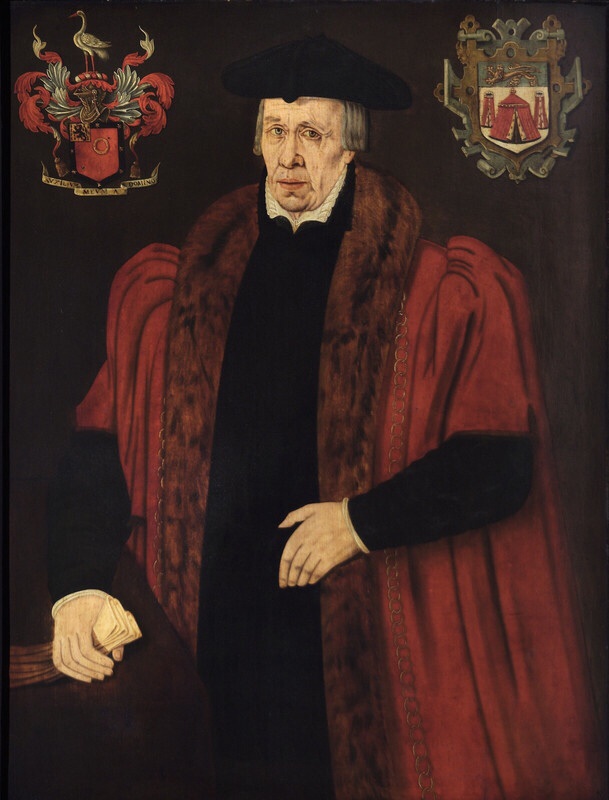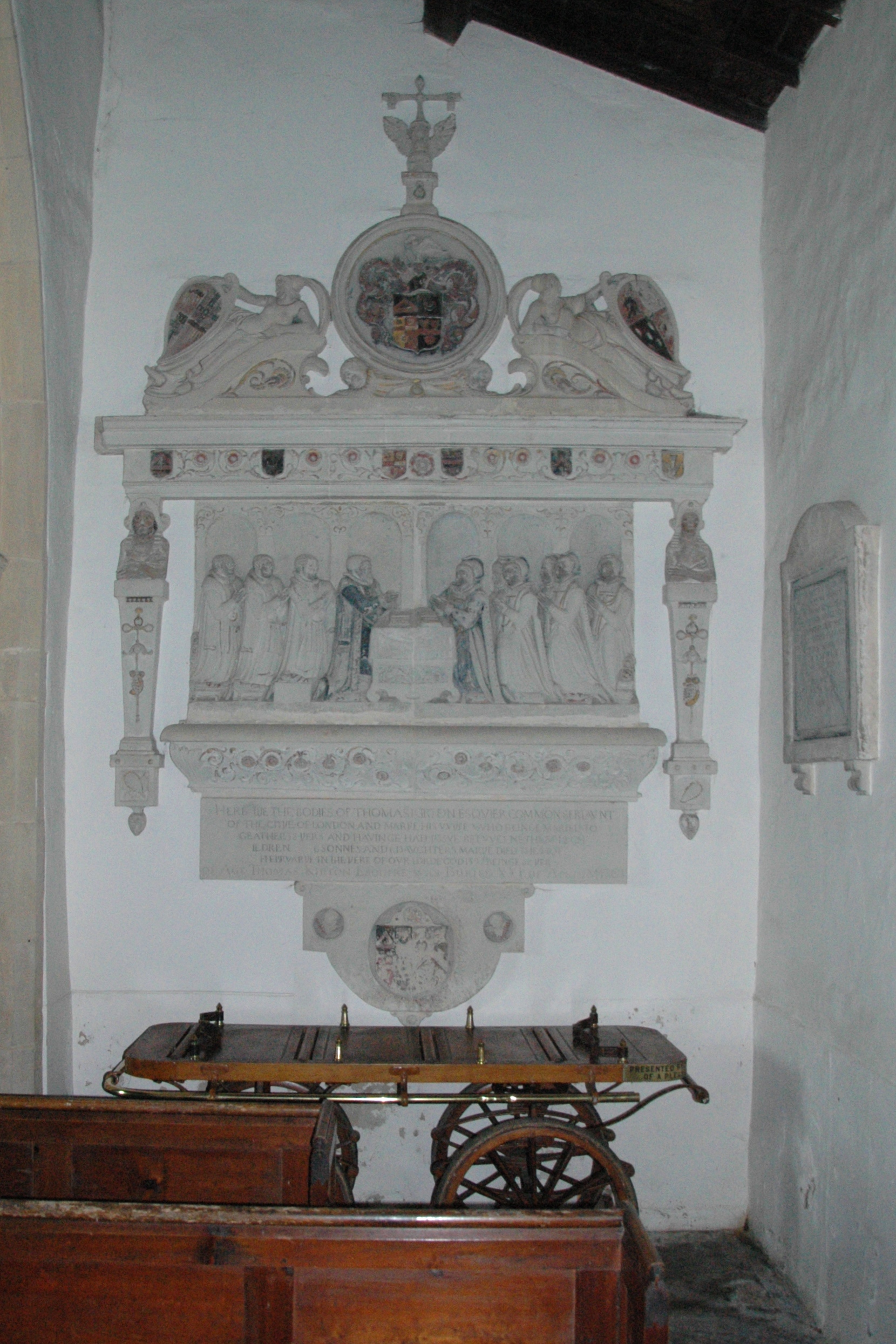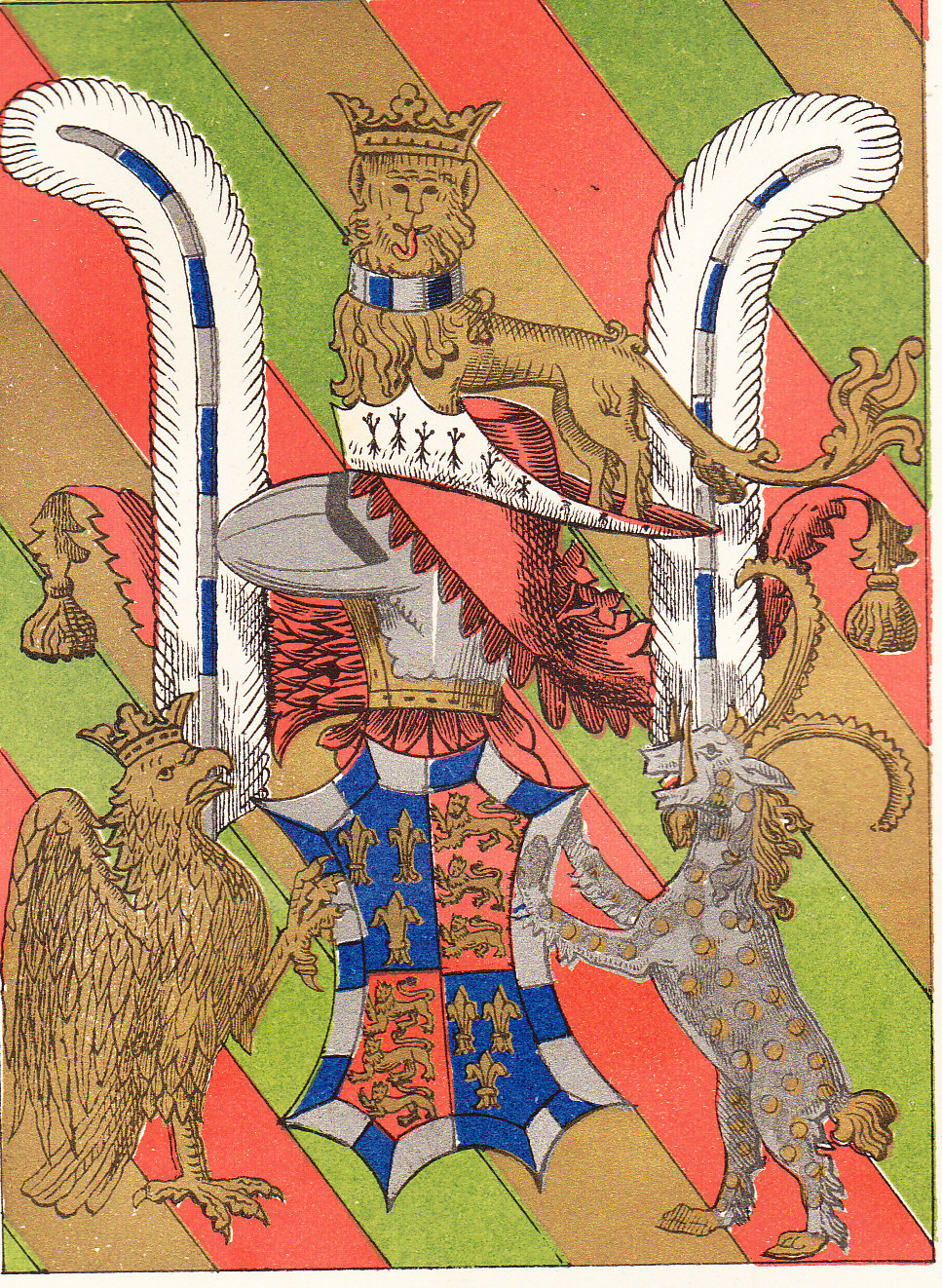|
Nicholas Woodroffe
Sir Nicholas Woodroffe (Woodruff, Woodrofe, etc.) (c. 1530–1598) was a London merchant of the Worshipful Company of Haberdashers, who, through the English Reformation, rose in the Alderman class to become a Master Haberdasher, Lord Mayor of London and Member of Parliament for London. Through the complexities of his family's relationships, and the position and security which they afforded, he lived to establish his family among the armigerous houses of late Elizabethan Surrey. Origins and early life Nicholas Woodroffe's father David (c.1503–1563) was born of a merchant family of Uffculme, Devon, who are supposed to have derived from the Woodroffes of Wolley in Royston, South Yorkshire. Admitted to the freedom of the Haberdashers in 1526, he married within the Company soon afterwards, and like his father-in-law John Hill, Haberdasher, became a Merchant of the Staple at Calais. Hill, 'whose ancestors were of the north,' had married Agnes Mowsdale, a goldsmith's daughter of Lon ... [...More Info...] [...Related Items...] OR: [Wikipedia] [Google] [Baidu] |
Worshipful Company Of Haberdashers
The Worshipful Company of Haberdashers, one of the Great Twelve City Livery Companies, is an ancient merchant guild of London, England associated with the silk and velvet trades. History and functions The Haberdashers' Company follows the Mercers' Company ( inc. 1394, also connected with clothing and previously haberdashery) in precedence, receiving its first Royal Charter in 1448 and holds records dating back to 1371. The formal name under which it is incorporated is ''The Master and Four Wardens of the Fraternity of the Art or Mystery of Haberdashers in the City of London''. The company was originally responsible for the regulation of silk and velvet merchants, but began losing control over those trades as the population of London increased and spread outwards from the City after the Industrial Revolution. Through careful stewardship of financial bequests and funds, the company now serves as a significant educational and charitable institution whilst maintaining links wit ... [...More Info...] [...Related Items...] OR: [Wikipedia] [Google] [Baidu] |
Cheap (ward)
Cheap is a small ward in the City of London. It stretches west to east from King Edward Street, the border with Farringdon Within ward, to Old Jewry, which adjoins Walbrook; and north to south from Gresham Street, the border with Aldersgate and Bassishaw wards, to Cheapside, the boundary with Cordwainer and Bread Street wards. The name Cheap derives from the Old English word "chep" for "market". The following roads run north to south across the ward: St. Martin's Le Grand, Foster Lane, Gutter Lane, Wood Street, Milk Street, King Street, and Ironmonger Lane. Within its boundaries are two Anglican churches: St Vedast Foster Lane and St Lawrence Jewry; a third church, St Mildred, Poultry, was demolished in 1872. Several Livery Halls are located in Cheap, including those of the Mercers', Goldsmiths', Wax Chanders' and Saddlers' Companies. A small part of the Guildhall lies within the ward's boundaries: the main entrance and main hall itself; the remainder is in Bassishaw ... [...More Info...] [...Related Items...] OR: [Wikipedia] [Google] [Baidu] |
Thomas White (merchant)
Sir Thomas White (1492 – 12 February 1567) was an English cloth merchant, Lord Mayor of London in 1553, and a civic benefactor and founder of St John's College, Oxford. Biography Thomas White was born in Reading, Berkshire, the son of William White, a clothier of Reading, and his wife, Mary, daughter of John Kibblewhite of South Fawley, also in Berkshire. He was brought up in London. Sir Thomas was twice married, to Avicia (died 1558) and to Joan. A principal member of the guild of Merchant Taylors, he served as Sheriff of London in 1547, and was elected Lord Mayor of London in 1553. He was knighted in the same year by Queen Mary I. He was a member of the commission for the trial of Lady Jane Grey. In 1555, inspired by the example of Thomas Pope, founder of Trinity College, Oxford, White obtained a royal licence for the foundation of St John's College, Oxford, dedicated to the patron saint of the Merchant Taylors and established in the buildings of the dissolved Ciste ... [...More Info...] [...Related Items...] OR: [Wikipedia] [Google] [Baidu] |
Sheriff Of London
Two sheriffs are elected annually for the City of London by the Liverymen of the City livery company, livery companies. Today's sheriffs have only nominal duties, but the historical officeholders had important judicial responsibilities. They have attended the justices at the Central Criminal Court, Old Bailey, since its original role as the court for the City and Middlesex. The sheriffs live in the Central Criminal Court, Old Bailey, during their year of service, so that one of them can always be attendant on the judges. In Court No 1 the principal chairs on the Bench (law), bench are reserved for their and the Lord Mayor's use, with the Sword of the City hanging behind the bench. It is an invariable custom that the Lord Mayor of London must previously have served as a sheriff. By a "custom of immemorial usage in the City",#Howell, Howell et al., p. 191 the two sheriffs are elected at the Midsummer Common Hall by the Liverymen by acclamation, unless a ballot is demanded from ... [...More Info...] [...Related Items...] OR: [Wikipedia] [Google] [Baidu] |
Thorpe Mandeville
Thorpe Mandeville is a village and civil parish in West Northamptonshire, England about northeast of Banbury in neighbouring Oxfordshire. The hamlet of Lower Thorpe is just north of the village. The village's name means 'Outlying farm/settlement'. The village was held by Richard de Amundevill in 1252. The population of the parish has grown slowly over the centuries. It was recorded as 137 in the 1801 Census, 178 in the 1991 Census, 194 in the 2001 Census and 327 (including Edgcote) in the 2011 Census. Manors The Domesday Book of 1086 records the village as ''Thorp''. "Mandeville" is a corruption of ''Amundeville''. Richard de Amundeville was lord of the manor in the 13th century. In 1346 a house and of land at Thorpe Mandeville were listed amongst the estates of the Augustinian priory at Chacombe. The Kirton family lived at Thorpe Mandeville manor house from 1554 to 1685. Thomas Kirton (1537–1601) of Thorpe Mandeville was Common Serjeant of London. The current ironst ... [...More Info...] [...Related Items...] OR: [Wikipedia] [Google] [Baidu] |
Achievement (heraldry)
In heraldry, an achievement, armorial achievement or heraldic achievement (historical: hatchment) is a full display or depiction of all the heraldic components to which the bearer of a coat of arms is entitled. An achievement comprises not only the arms displayed on the escutcheon, the central element, but also the following elements surrounding it: * Crest placed atop a: * Torse (or Cap of Maintenance as a special honour) * Mantling * Helm of appropriate variety; if holder of higher rank than a baronet, issuing from a: * Coronet or Crown (not used by baronets), of appropriate variety. * Supporters (if the bearer is entitled to them, generally in modern usage not baronets), which may stand on a Compartment * Motto, if possessed * Order, if possessed * Badge, if possessed Coat of arms Sometimes the term "coat of arms" is used to refer to the full achievement, however this usage is incorrect in the strict sense of heraldic terminology, as a coat of arms refers to a garment ... [...More Info...] [...Related Items...] OR: [Wikipedia] [Google] [Baidu] |
St Andrew Undershaft
St Andrew Undershaft is a Church of England church in the City of London, the historic nucleus and modern financial centre of London. It is located on St Mary Axe, within the Aldgate ward, and is a rare example of a City church that survived both the Great Fire of London and the Blitz. The present building was constructed in 1532 but a church has existed on the site since the 12th century. Today, St Andrew Undershaft is administered from the nearby St Helen's Bishopsgate church. History The first church on the site, which today is bordered by St Mary Axe and Leadenhall Street, was built in medieval times, being recorded in 1147. It was rebuilt in the 14th century and again in 1532; this third incarnation of the building survives today. It is in the Perpendicular style with its entrance located at the base of its off-centre tower. The interior is divided into six bays, with many of the original fittings that survived Victorian renovation. Formerly, St Andrew Undershaft had one ... [...More Info...] [...Related Items...] OR: [Wikipedia] [Google] [Baidu] |
Mary I Of England
Mary I (18 February 1516 – 17 November 1558), also known as Mary Tudor, and as "Bloody Mary" by her Protestant opponents, was Queen of England and Ireland from July 1553 and Queen of Spain from January 1556 until her death in 1558. She is best known for her vigorous attempt to reverse the English Reformation, which had begun during the reign of her father, Henry VIII. Her attempt to restore to the Church the property confiscated in the previous two reigns was largely thwarted by Parliament, but during her five-year reign, Mary had over 280 religious dissenters burned at the stake in the Marian persecutions. Mary was the only child of Henry VIII by his first wife, Catherine of Aragon, to survive to adulthood. Her younger half-brother, Edward VI, succeeded their father in 1547 at the age of nine. When Edward became terminally ill in 1553, he attempted to remove Mary from the line of succession because he supposed, correctly, that she would reverse the Protestant refor ... [...More Info...] [...Related Items...] OR: [Wikipedia] [Google] [Baidu] |
Lime Street (London)
Lime Street is a minor road in the City of London between Fenchurch Street to the south and Leadenhall Street to the north. Its name comes from the lime burners who once sold lime from there for use in construction. It is perhaps best known as the current home of the world's largest insurance market, Lloyd's of London, since its newest building was opened on the street in 1986. Opposite Lloyd's, the Willis Building is the global headquarters of insurance broker Willis. A 35-storey building stands at 52-54 Lime Street as the European headquarters of global insurer W. R. Berkley. The northern portion of the street is pedestrianised. Vehicular through-access to Leadenhall Street is prevented by a firegate, forcing drivers to bear right onto Fenchurch Avenue, from which a left turn onto Billiter Street returns vehicles to Leadenhall Street. Nearby is the Norman Foster-designed and gherkin-shaped skyscraper 30 St Mary Axe, and the Leadenhall Building. Leadenhall Market is on L ... [...More Info...] [...Related Items...] OR: [Wikipedia] [Google] [Baidu] |
Stephen Jenyns
Sir Stephen Jenyns (–1523) was a wool merchant from Wolverhampton, Merchant of the Staple and Master Merchant Taylor who became Lord Mayor of London for the year of the coronation of King Henry VIII. An artistic, architectural and educational patron, he founded Wolverhampton Grammar School, and took a leading part in the rebuilding of the church of St. Andrew Undershaft in the City of London. Origins and early life Stephen Jenyns was, according to the Heraldic Visitations of Staffordshire (1614, 1663 and 1664), the son of William Jenyns of Tenby, Pembrokeshire, and his wife Ellen, daughter and coheir of William Lane of Wolverhampton. He was born at Wolverhampton shortly before 1450, and was apprenticed to a London tailor in 1462–63. He settled in London and became a prominent member of the Fraternity of Taylors and Linen Armourers of St. John the Baptist. In 1485 he and two others supported Hugh Pemberton, a senior Taylor, in a bond for payment of £920 for Pemberton's acti ... [...More Info...] [...Related Items...] OR: [Wikipedia] [Google] [Baidu] |
Wolverhampton
Wolverhampton () is a city, metropolitan borough and administrative centre in the West Midlands, England. The population size has increased by 5.7%, from around 249,500 in 2011 to 263,700 in 2021. People from the city are called "Wulfrunians". Historically part of Staffordshire, the city grew initially as a market town specialising in the wool trade. In the Industrial Revolution, it became a major centre for coal mining, steel production, lock making, and the manufacture of cars and motorcycles. The economy of the city is still based on engineering, including a large aerospace industry, as well as the service sector. Toponym The city is named after Wulfrun, who founded the town in 985, from the Anglo-Saxon ''Wulfrūnehēantūn'' ("Wulfrūn's high or principal enclosure or farm"). Before the Norman Conquest, the area's name appears only as variants of ''Heantune'' or ''Hamtun'', the prefix ''Wulfrun'' or similar appearing in 1070 and thereafter. Alternatively, the city ma ... [...More Info...] [...Related Items...] OR: [Wikipedia] [Google] [Baidu] |
Stafford
Stafford () is a market town and the county town of Staffordshire, in the West Midlands region of England. It lies about north of Wolverhampton, south of Stoke-on-Trent and northwest of Birmingham. The town had a population of 70,145 in the 2021 census, It is the main settlement within the larger borough of Stafford which had a population of 136,837 (2021). History Stafford means "ford" by a staithe (landing place). The original settlement was on a dry sand and gravel peninsula that offered a strategic crossing point in the marshy valley of the River Sow, a tributary of the River Trent. There is still a large area of marshland north-west of the town, which is subject to flooding and did so in 1947, 2000, 2007 and 2019. Stafford is thought to have been founded about AD 700 by a Mercian prince called Bertelin, who, legend has it, founded a hermitage on a peninsula named Betheney. Until recently it was thought that the remains of a wooden preaching cross from the time h ... [...More Info...] [...Related Items...] OR: [Wikipedia] [Google] [Baidu] |
_p2.019_-_Haberdashers_Hall%2C_Maiden_Lane.jpg)







